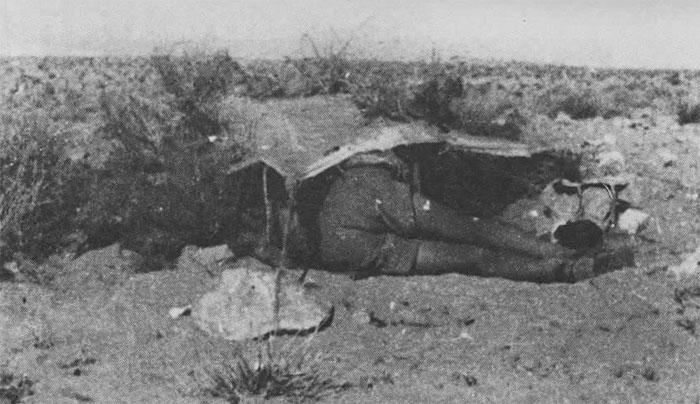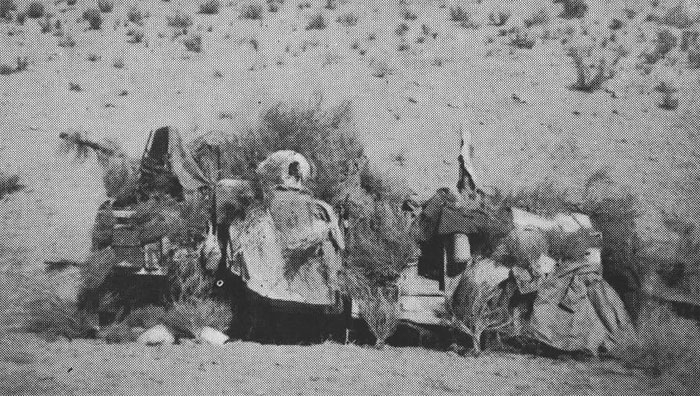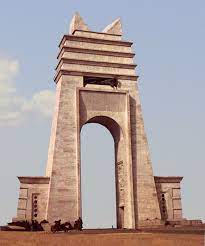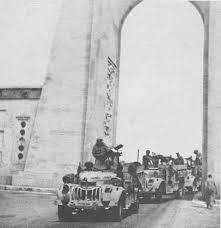In a staged photograph, two troopers are about to begin a road watch. Road watches typically consisted of two man patrols set out for a 24 hour stint. Note the balaclavas and Tropal coats. The rifle is probably the No1, Mk III SMLE by virtue of the graduated rear sight located in front of the bolt.

A principle job of the LRDG was reconnaissance this included Road Watches. The men would be dropped off at an observation site near the road, with a day's ration of food and water. Their first task would be to bury their food and water nearby. This hid the food from the enemy as well as helped to keep their water cool.
Sometimes a they would carry a weapon but just as often they would go unarmed. It was doubtful that two men armed with rifles would be able to put up a strong defense against a column of the enemy if they were spotted. So often the men would go unarmed hoping that if they were captured, they would be mistaken for lost stragglers or recent escapees, perhaps even deserters. This would possibly prevent the enemy from searching for their mates.
Any possible cover was used, be it a desert scrub or just a low depression in the ground. When night fell the patrol would move closer to the road or rely on their hearing to count the enemy movement. Typically the men would use binoculars or a telescope to watch the movement. In the photograph above, a pair of No.2 Mk III 6x30 binoculars are just visible. These were standard issue binoculars for the British Army during were WWII.
The two man RECCE team would record anything and everything that passed their spot.

RECCE Position
An LRDG trooper occupies a road watch. The shrub and shelter half provide shelter from the sun and helps conceal him from observation. A small survival or "bail out" kit rest next to his feet. The sand offers no support for tent pegs so a heavy rock is used to secure the tie-down line.
Getting To A Road Watch And Not Being Discovered
The purpose of the road watch is explained further in the Mission section and in the Kit Bag. The purpose of this page explore getting to a road watch and not being discovered. At times, the LRDG was several hundred miles away from any support and their only hope for survival depended only on the tools they brought with them and their own ingenuity. Above all with any reconnaissance work, not being seen is the number one priority.
When setting up a road watch, a position has to be carefully selected. It must afford both a view of the road and a place of concealment that does not appear obvious to the enemy. It is also important to cover your tracks so that tell-tale signs do not give away your location. For instance an airplane may fly over the desert and miss a camouflaged vehicle because it takes up a space of 21x9 feet (7X3 meters) but it is not going to miss that obvious pair of parallel lines that track for 60 miles (100km).
To remedy this, the LRDG would often drive past the location of the desired road watch for some distance and then carefully drive back over their own tracks to a place where they would cut off at a 90 degree angle from the course they were on and move into a position a few miles away. After doing so, they would then have to erase the tracks from where they stopped back to the turn off point.
Once this is done, the truck would be camouflaged and the men would choose the road watch position. The road watch site would be one to three miles from the truck. As with the tracks left by the truck, it was important to cover the tracks left going to and from the road watch. If the soldiers at the road watch were discovered there was the possibility their foot prints could be traced back to the truck.
The position itself would also be camouflaged and concealed against enemy aircraft and ground observation. Weapons and rations would be buried nearby, and in some cases the two men on watch may be in separate supporting spots to make it easier to hide and not allow two men to get captured at the same time.
Once two men were in position they would be there for twenty four hours, until relieved or in some cases would leave at a prescribed time at which point they would head back to the truck or some rallying position. Upon leaving the road watch position, it would be returned to its original look. The most dangerous time was coming to going from the road watch position. It was never safe to come back to the same position because there was always the possibility that it was discovered while you were gone however, sometimes the LRDG had no choice.

Hiding in the open
A 30 CWT is camouflaged against ariel view. The truck may be armed with a 20mm Breda. Shrubs and clothing have been used to conceal the wheels and to breakup the outline of the vehicle. It is difficult to say if this is the finished product for a long time concealment or just a hasty job for a temporary halt. There are stories of trucks with a simple net thrown over them not being seen by enemy convoys passing within 500 yards (meters).
Marble Arch
Located on the main coastal road between Tripoli and Tobruk, Marble Arch was a symbol of Mussolini's conquest of Libya. It is also the scene of the longest running and possibly the most important road watch established by the LRDG. Beginning in March of 1942 and running until 21 July 1942, the LRDG ran a continuous road watch five miles east of the arch. Each patrol would come out for an eleven day shift with the road watch itself comprised of a two man team watching the road for 24 hours at a stretch. During the day, the men hid in a shelter similar to the one above, with one man watching easterly traffic and the other, westerly. At night they could move a round a bit, and typically one man would sleep and the other watch. Traffic was said to have been busiest in the morning and evening. If possible the men were to report every detail down to bumper numbers, number of personnel, type of equipment and any thing else that could be discovered. Reports would be sent back to LRDG HQ's every night.
Read The Desert My Dwelling Place for more info on this road watch

L'arco dei Fileni de Mussolini (Marble Arch)
The Arch was destroyed by Muammar Abu Minyar al-Gaddafi around 1970.
(image color enhanced)
Pass in Review!
A composite image showing detail of the Arch. The image is actually a composite of two images. see the small insets below. The real arch photo showed a convoy from a petrol company passing through the arch around the time of World War II. The other image is a T patrol just setting out on Patrol.
The combined image is in no way historically accurate and should be seen for what it is, A whimsical composite of the road and the men who watched it for an almost continuous five months!



Read more:
